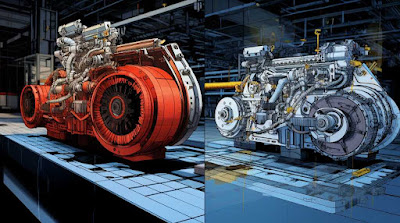Engine and Automotive Engineering
Engine and automotive engineering is a fascinating field that encompasses the design, development, and optimization of vehicles and their components. Here's a broad overview of what it involves:
Engine Engineering
1. Internal Combustion Engines (ICE)
- Design and Optimization: Focus on improving performance, efficiency, and emissions. This includes work on engine blocks, pistons, crankshafts, and cylinder heads.
- Fuel Systems: Developments in fuel injection systems, carburetors, and fuel pumps to improve fuel efficiency and power output.
- Combustion Chambers:Design and analysis of combustion chambers to optimize the burning process for power and efficiency.
2. Alternative Power trains
- Electric Motors: Designing electric drive trains, including motors, batteries, and control systems.
- Hybrid Systems: Combining internal combustion engines with electric propulsion to improve fuel efficiency and reduce emissions.
- Hydrogen Fuel Cells: Working on fuel cell technology and hydrogen storage to create zero-emission vehicles.
3. Performance Engineering
- Tuning and Testing:Enhancing engine performance through tuning and dyno testing, including optimizing air-fuel ratios and ignition timing.
- Thermal Management: Developing systems to manage engine temperatures for optimal performance and longevity.
Automotive Engineering
1. Vehicle Dynamics
- Suspension Systems: Designing and improving suspension systems for better handling, comfort, and safety.
- Braking Systems: Developing advanced braking technologies like ABS, traction control, and regenerative braking systems.
2. Vehicle Electronics
- Control Systems: Integrating electronic control units (ECUs) for engine management, transmission control, and safety systems.
- Infotainment Systems: Developing systems for navigation, entertainment, and connectivity.
3. Safety and Regulation
- Crashworthiness: Designing vehicles to meet safety standards and improve occupant protection during collisions.
- Regulatory Compliance: Ensuring vehicles meet emissions, safety, and other regulatory requirements.
4. Manufacturing and Materials
- Production Techniques: Improving manufacturing processes for efficiency and quality, including automation and lean manufacturing.
- Material Science: Selecting and developing materials to balance strength, weight, and cost. This includes advanced composites and lightweight metals.
5. Sustainability
- Eco-Friendly Technologies: Developing technologies to reduce environmental impact, such as alternative fuels, electric vehicles, and efficient manufacturing processes.
- Recycling and Lifecycle Management:Ensuring that vehicles and their components are designed with end-of-life recycling and reuse in mind.
Automotive engineering is a dynamic field with constant innovation, driven by advancements in technology and changes in regulatory and market demands. Whether you're interested in the mechanics of engines or the design of new vehicle systems, there's a lot to explore and work on.


Comments